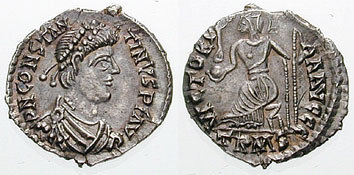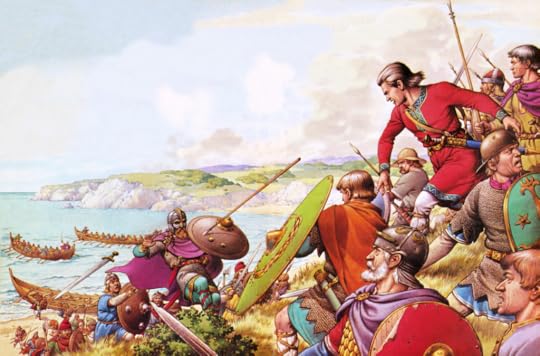The Year of the Three Emperors and the Fall of Roman Britain
 This silver Roman coin called a ‘siliqua’ depicts Constantine III, Britain’s homegrown usurper, who stripped the island of the last of its troops in 407.
This silver Roman coin called a ‘siliqua’ depicts Constantine III, Britain’s homegrown usurper, who stripped the island of the last of its troops in 407.My next installment in the Dragon of the North trilogy – The Pictish Crown – is set during a tumultuous and fascinating period in which Britain went from being a frontier diocese of the Roman Empire to an independent island left open to invasion by barbarian peoples and squabbled over by petty tyrants. After four hundred years of occupation, Rome simply washed its hands of the troublesome island. How and why are questions that historians (and writers) have been puzzling over for centuries.
By the late 4th-century, Rome had been facing increasing troubles on the continent, necessitating the need to draw troops from Britain to defend other territories. Severely undermanned, Britain’s frontier defenses like Hadrian’s Wall and the the so-called Saxon Shore were vulnerable to attack. Coinage had also dried up, meaning the few troops in Britain hadn’t been paid in quite some time. For an island that had revolted several times under Roman rule, another rebellion seemed inevitable.
In 406, the military stationed in Britain took matters into their own hands and elected one of their own as emperor. This had happened before. In 383, Magnus Maximus, a high-ranking general, proclaimed himself emperor and marched on Gaul to legitimize his claim (creating yet another drain on Britain’s military resources). The rebellion of Maximus was a failure but that wasn’t about to stop the Britons from trying again. This new emperor was called Marcus and his reign was, by all accounts, short and unpopular. He didn’t even last a year before he was killed and replaced by one Gratian who, unlike previous usurpers was not a military man but a member of the urban aristocracy.
Perhaps the aim was to rectify trade and tax problems but, in the winter of 406, disaster happened. A confederation of Germanic barbarians consisting of the Vandals, the Alans and the Suebi crossed the River Rhine, Rome’s northern boundary on the continent, and entered the empire. Order in northern Gaul collapsed and Roman towns were looted and burned. This was frightening stuff for the island of Britain which had little in the way of troops to defend it. If the barbarians could march into Gaul unstopped, then they could easily cross over into Britain.
It was clearly decided that a military man was the way to go after all, which was bad news for Gratian who was summarily executed and replaced by a soldier called Constantine (Britain’s third usurper in less than a year). Constantine, it is said by the historian Orosius, was picked largely because he shared a name with Constantine the Great, one of Rome’s most fondly remembered emperors who had also come to power through a coup in Britain. This new Constantine certainly had the backing of the troops stationed in Britain who followed him into Gaul to fight the barbarians, hoping to stop them from reaching British shores.
 Left undefended, the Romanised Britons had to fend off attacks from barbarians like the Saxons with no help from Rome.
Left undefended, the Romanised Britons had to fend off attacks from barbarians like the Saxons with no help from Rome.Britain was now almost wholly abandoned with no legions left to protect it. While Constantine fought for legitimacy on the continent, British shores were attacked by Saxons. Many Britons, angered at the failure of their homegrown emperor to protect them, staged yet another coup in either 409 or 410 and expelled Constantine’s officials, taking control of the island for themselves.
While Constantine was eventually recognised as co-emperor of the West by Emperor Honorius, he was betrayed by one of his own generals and eventually defeated and executed. But Rome was in no state to reclaim its wayward diocese. Emperor Honorius faced uprisings and barbarian invasions for the rest of his rule and the rule of his largely inept successor, Valentinian III, was dominated by civil wars and invasion by the Huns. 410 officially marks the end of Roman Britain.
What happened in Britain in the following centuries during the so-called ‘Dark Ages’ is tangled up in myth, with few and fragmentary sources. It was undoubtedly an age of invasion by Picts, Saxons and Gaels and a time of tyrants like the mysterious ‘Vortigern’ not to mention the great British hero Arthur. One other figure who rose to prominence during this time was Cunedag (or ‘Cunedda’) who defended what is now North Wales from the Gaels, thus founding the Kingdom of Gwynedd.
While Cunedag was a young soldier stationed on Hardian’s Wall in Defender of the Wall, book 2 finds him a king of his own tribe, though still wholly dedicated to protecting Britain as Rome’s control over the island slips away. The Pictish Crown will be published on April 30th and you can preorder your copy here!




